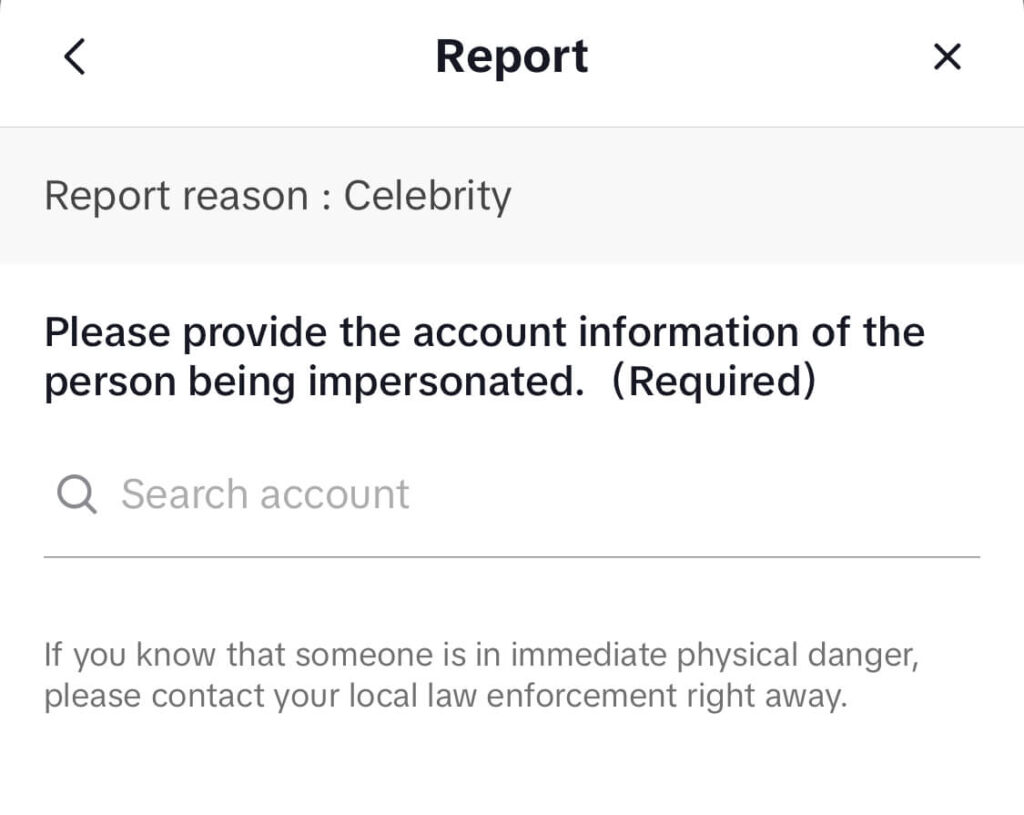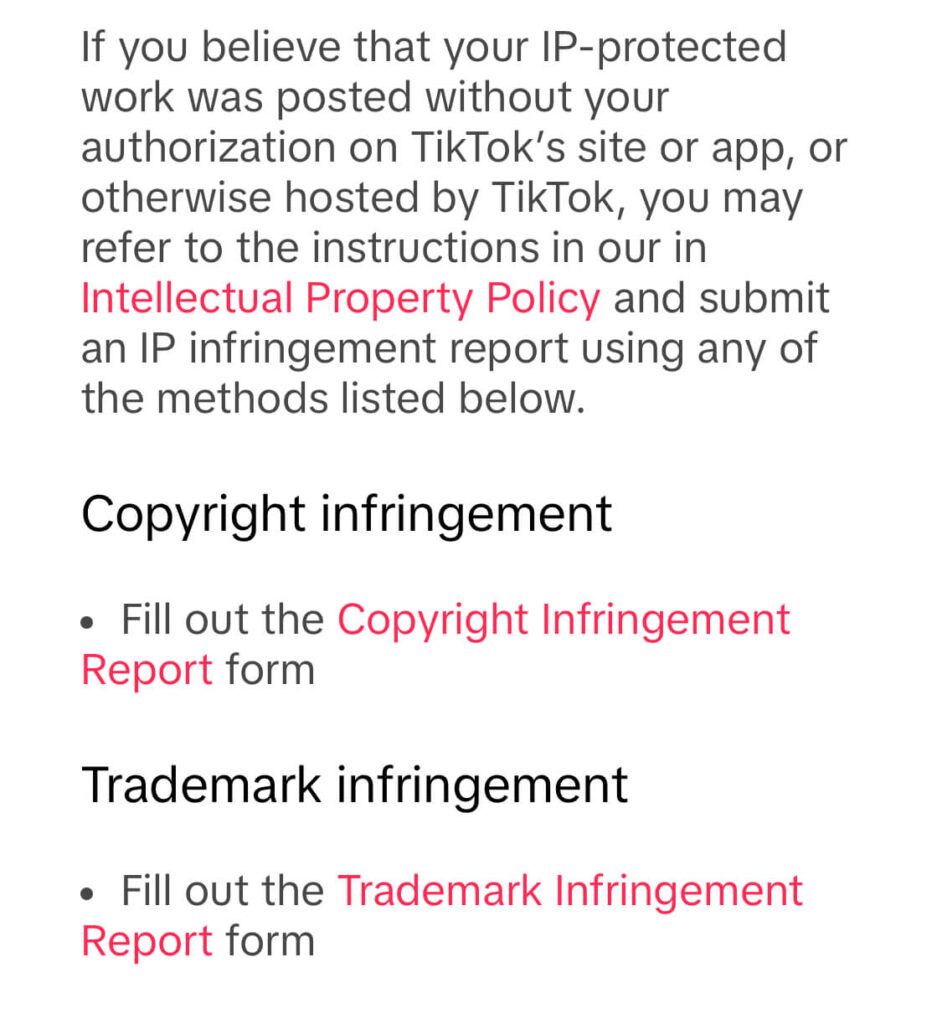Have you found TikTok accounts posing as your brand or selling counterfeits? Unfortunately, this is a common story.
The scam account might sell inferior products or it could pose as a storefront to collect payment from customers without sending any products.
You can report a TikTok account in a few ways depending on the type of infraction. But in our experience, scams can proliferate on the platform easily. It’s hard to manually track and report new fake accounts on your own.
That’s where our AI-powered brand protection platform can be helpful, which scans social media apps like TikTok for unauthorized use of your IP.
In this article, we’ll show you how to report a TikTok account and how to get TikTok accounts deleted at scale with our automated tools.
How to report fake TikTok accounts step-by-step
Since TikTok does not actively take down fake accounts, you have to manually report them. We’ll show you the process here.
Step 1: Locate the report option
You can find the report option inside the share menu on mobile. Access the share menu with the arrow icon at the top or bottom right corner of a post or page:

From a desktop computer, you’ll find the report option by clicking on the three menu dots:

Then select Report.

Keep in mind, if there are multiple infringing accounts or posts, you’ll have to report each one separately. Our automated platform can collect information on TikTok infringements and report multiples at once, on the other hand.
Step 2: Choose what type of report to make
TikTok lets you report content for a variety of reasons, including:
- Impersonation
- Fraud and scams
- Intellectual property violation

If you select Pretending to be someone, you can choose a verified TikTok account that the user is impersonating.

If you select Fraud and scams, you’ll submit a report for TikTok to analyze the content for its fraud and scam policy.

You can complete impersonation and fraud/scam reports just by submitting the user to TikTok at this step.
Step 3: Complete a copyright or trademark infringement form
If you want to report a page for counterfeit or trademark infringement, you’ll complete a more detailed form. Choosing one of these options will bring up the following page:

You’ll see options for the copyright infringement report and trademark infringement report. Within these reports, you can report either user-generated content or content in TikTok advertisements and shops. If you want to report content in a shop or ad, you’ll see a separate report for IP infringement in advertising.
These forms can take some time to complete as they require proof of your IP and proof of authorization if you’re acting on behalf of a company. If you have to enforce multiple infringements, our platform can save you time and allow you to report at scale.
The three forms require similar information, so we’ll cover the advertising IP report below.
Choose the complaint details
Choose whether to submit a complaint about a copyright or trademark violation and add the type of IP and the URL of the infringing content.

Provide ownership or trademark information
Next, provide more details about your ownership of the IP. For a copyright infringement, you’ll provide your identity, location of the original work, proof of rights and authorization, plus any other materials you think would help your case.
If you’re reporting trademark infringement, you’ll provide your identity, location of the trademark, trademark jurisdiction, and registration number, plus proof of rights and additional materials. If you use our brand protection platform, we automatically collect evidence and upload proof of ownership, so you don’t have to hunt down documents for each case.
The next step in reporting a TikTok account is to provide your contact information.
Sign legal affirmations
Finally, agree to a few legal affirmations, sign the report, and submit.
When you use our platform, we report directly to TikTok, which streamlines this whole process.
Step 4: Monitor the TikTok report
TikTok has IP specialists in different countries and time zones, so it’s usually pretty quick to respond to a legitimate complaint. It can take a day or two for the content to be taken down. TikTok will notify you through email when this happens.
If you’re dealing with multiple infringements, tracking the status of each can be confusing. Our reporting dashboard makes this easy since you can see the status of each complaint and filter for takedowns in different stages.
TikTok’s limitations in counterfeit and trademark protection
TikTok’s system provides the basic functions of counterfeit and trademark infringement reporting. There are some limitations, though. You have to manually find the accounts to report in the first place since TikTok won’t notify you if a new account uses your image or logo.
Also, you have to keep checking to monitor a report’s process. The recipient could submit a counterreport and draw out the process. It’s important to stay on top of these counter reports since TikTok could drop your case if you don’t respond or provide more information.
Its situations like these where having a brand protection platform can be helpful. Our automated systems regularly scan TikTok for your IP, not just with text searches but with image search algorithms, as well. And when we report infringements, we keep an eye on communication and provide extra evidence if needed.
Proactive monitoring for future fake TikTok accounts
Filing IP reports is just one part of keeping your brand safe on TikTok. Even if you don’t use the platform, you should monitor regularly to catch fake accounts before they snowball and take your customers’ money or informatio
Look out for counterfeits
Slowly and steadily TikTok has become a huge base for counterfeit products – fake accounts crop up one day and disappear the next day before you can even report them or take any legal action against them.
Monitor your brand hashtags on TikTok to ensure there aren’t any counterfeit products of your business being sold online.
To safeguard your business, you can also mention all the official retail channels of your business and state that you do not sell directly through TikTok.
Consider setting up a Google alert to catch new mentions of your brand on different platforms including TikTok.
Search for fake imitation accounts and squatters
Imitation accounts pretend to be the official accounts of businesses to fool unsuspecting customers. When users search for your business on the TikTok app, they may unknowingly be led to a fake account that appears to be authentic.
Many of the scammers use account handle names like [brand name]_official or official_[brand name] to look genuine.
Get the verified badge
TikTok offers a verified badge to notable people and entities. You can apply for a badge by opening Settings and then tapping Account and Verification. You’ll need to supply multiple links to mentions of your brand in news outlets (not paid ads). Having the verification checkmark makes it easier for your customers to distinguish your legitimate account.
Protect your intellectual property on TikTok
When you are reporting fake accounts to TikTok, you may have to prove that the business name or the content on the fake accounts belongs to your business. That can only be possible if you own all the intellectual property of your business.
While copyrights help you protect original works of authorship, trademarks protect your brand name, logo, and official colors.
Protecting your intellectual property means when a scammer does end up creating a fake TikTok account with the name of your business, you have the ability to take legal action against them.
What’s next
To recap, you can report an account on TikTok for fraud, scams, counterfeit products, or intellectual property violations. You can do so through the app on a mobile device or desktop computer.
However, TikTok’s reporting systems have limitations, though. You have to manually search for infringing accounts, and keyword searching might not be enough. Scammers can avoid using branded terms, which is why using image search with a platform like Red Points can be so helpful.
Our AI-powered brand protection software can search social media apps in different ways to uncover TikTok users using your designs or promoting fake products. If you want to eliminate the headache of scam TikTok accounts, reach out for a demo to see Red Points in action today.







